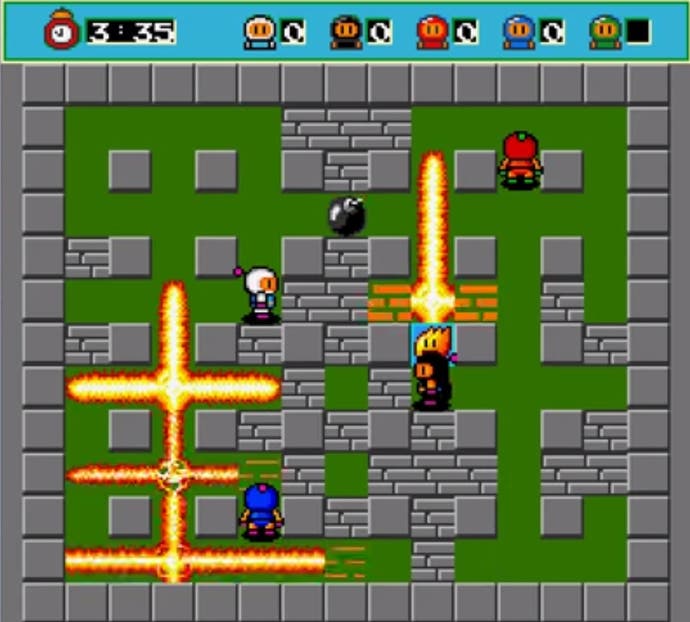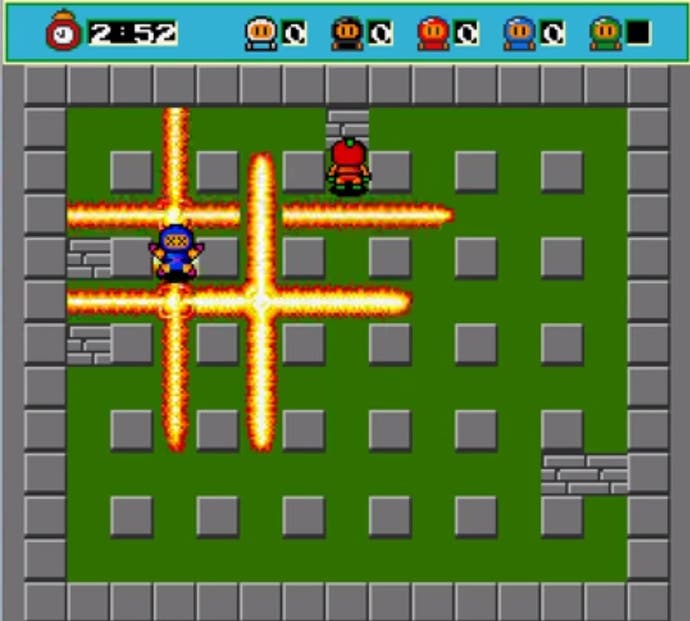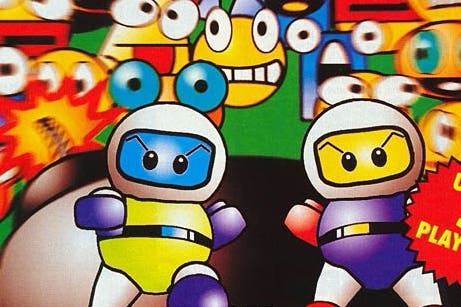Remembering Dyna Blaster, the first Battle Royale game I played
Last Bomberman standing.
26 years on, the opening ditty to Dyna Blaster on the Amiga is still seared into my memory, a perfect, personal time capsule that exists nowhere else but my brain. I only need to hum the first 10 seconds of that jingle and suddenly I'm transported back in time to 1991. 12 years old and huddled around an Amiga 500+ with four of my friends in a tiny bedroom in Garsington, Oxford.
God, we had so much fun playing Dyna Blaster's Battle Mode that summer. With every match we'd laugh until our sides hurt and tears ran down our cheeks. We'd scream with excitement at every kill, we'd jostle and punch arms with every loss and we'd continue on that way for hours until a hungry belly, or an exasperated parent sent us home.
If you're not familiar with Dyna Blaster by the way, that's probably because you knew it by a different name. Dyna Blaster was the name given to the European versions of Bomberman that came out in 1991. It's a replacement name that lacks the snap of the original but at least it's better than 'Eric and the Floaters" the unfortunate title given to the 1983 version of Bomberman for the ZX Spectrum. But anyway, I digress.
Ever since the release of PlayerUnknown's Battlegrounds I've been thinking a lot about Dyna Blaster. For me, PUBG elicits many of those intense feelings I had in 1991 - the highs, the lows, the fear and the adrenaline. That's because, when you look closely at the gameplay loops of both games and understand the way the matches play out, beat by beat they're almost identical.
At the start of either game, players are on a level footing, alone, defenseless and with a basic attack. In PUBG that attack is a simple punch, in Dynablaster, a single bomb with a limp explosion, good for nothing more than removing surrounding blocks.
As the rounds in each game begin there's always short period of time before players meet up - the looting phase if you will. The anticipation of conflict is the driving force here and in Dyna Blaster the race to quickly remove blocks and uncover as many power-ups as possible is all consuming. Finding extra bombs means there's a higher chance of trapping an opponent between a succession of well placed explosives, whilst extending the blast radius of bombs with a Flame power-up increases the likelihood of taking out someone from a distance. In later installments of Bomberman other power-ups would appear, like roller skates that increased player speed or gloves that allowed bombs to be thrown over walls like grenades. The more power-ups a player collects, the greater their chance of surviving their first enemy encounter.

This opening chapter of hurried, panicked preparation plays out in exactly the same way in games like PUBG or Fortnite Battle Royale. In these you land, you loot and you prepare to shoot. In PUBG weapon attachments and high tier armours replace Dyna Blaster's cartoony power-ups, in Fortnite it's weapons of varying rarity. In the end though, it all boils down to the same thing - players need to rely on speed, forward-planning and a certain level of luck if they are to succeed.
When it finally comes to combat, again we can see tactics mirrored in both games. Some PUBG players will lay in wait in bathrooms, ready to pounce like a trapdoor spider. (We all know how spiders love a good bathroom.) By placing a medkit on the floor just inside the room they can entice people into their lair and then quickly dispatch them while they're tabbing the health into their inventory. In Dyna Blaster a clever player will wait for a greedy opponent to run down a tight corridor towards a power-up before rushing in to block their only exit with a bomb. Others, confident in their abilities, will take on the role of hunters, chasing down those who were less fortunate when it came to loot placement in the early minutes of the match.
You have to move a little further forward in the Bomberman franchise to see another similarity. In Super Bomberman 2, when a player meets their maker, the items they were holding are scattered across the arena, prompting a looting frenzy amongst the surviving players. This is not unlike something you'll witness in PUBG when, at the end of a prolonged shootout, players scramble to be the first to reach the corpse crates and take their pick of the contents. It's a risky maneuver that puts the scavengers into harm's way but the potential for a huge payout means it's often worth that extra exposure to danger.
Even PUBG's shrinking play area is something that we've seen before in the Bomberman games. Over time, danger zones push the remaining players together, forcing them into some kind of showdown, or consigning them to an embarrassing death. In the case of PUBG there's an electric field, in H1Z1 the danger zone is a thick green gas. In the Bomberman games it's a series of indestructible blocks that rain down from above in an ever decreasing circle, crushing anyone unlucky enough to be standing underneath.

Throughout these matches the one-life-and-you're-out factor is the core mechanic that drives players on. You either win or you die, there is no inbetween. It's this constant fear of oblivion that's the magic ingredient in all of these games. It delivers that heart in the mouth panic when an enemy is close, that gut punch of regret when you make a stupid and fatal mistake and that intense wash of adrenaline when finally, the smoke clears and you find you're the last person left alive in the arena.
So while Dyna Blaster's tiny arenas may not be as grand as PUBG's islands and the player count may only be a fraction of what you'll find in Erangel, the feelings I get when playing both games are almost indistinguishable. In fact, the biggest difference I can see between Dyna Blaster and PUBG is that - thanks to the online nature of Brendan Greene's game - I can't lean over and deliver a dead arm to the person who finally killed me. That'll have to be something I experience in my memory next time I decide to hum the Dyna Blaster theme tune.


